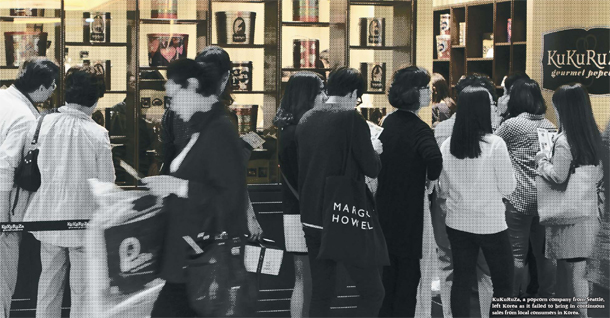After frenzy, foreign desserts fail to stay sweet : Imported treats start strong, but quickly lose steam as shoppers move on

KuKuRuZa, a popcorn company from Seattle, left Korea as it failed to bring in continuous sales from local consumers in Korea. [JOONGANG ILBO]
Why are big name dessert shops not doing well in the Korean market? There could be many reasons, but some point to the fact that Korean consumers are constantly looking for new things and check meticulously how products imported into the local market are different from the ones available overseas in terms of taste and price, along with the number of available menu items.
In July 2015, images from Pierre Herme , one of the iconic macaron shops in Paris, dominated the newsfeeds of anyone who would claim themselves a foodie, as it opened its first store at Hyundai Department Store’s COEX branch in southern Seoul.
The department store at the time rolled up its sleeves to promote this internationally known shop saying that it was “the best dessert brand of this generation.” The promise wasn’t all wrong as the company runs many international stores in Japan and Hong Kong, as well as being the fourth generation of the family that has made desserts in France. It even already established a strong fan base in Korea, as those who had tasted the treats in France anxiously waited for a local branch to open. When The Shilla Seoul hotel sold the macarons for two weeks in 2010, there was a long line every day.
Thanks to the fame the shop already had, it saw over 40 million won ($33,200) in sales on its opening day. However, only about a year after its opening, Pierre Herme’s first store was replaced with another bakery.
A similar story goes for the cheesecake from The Cheesecake Factory, one of the most-loved desserts from the United States. After it entered the local market in 2013, the brand has also pulled itself out of department stores, adding that it is now only focusing on providing products to cafes instead of directly selling cakes to consumers. Other brands including KuKuRuZa, a popcorn shop, and L’eclair de Genie which makes eclairs, made grand entrances into the market but have quietly disappeared.

L’eclaire De Genie, left, a French eclair brand, and Pierre Herme, middle, which makes French macarons alongside cheesecakes by The Cheesecake Factory from the United States, were all hyped online and offline soon after they opened shops in Korea. [JOONGANG ILBO]
It was easier for a dessert brand from overseas to make it big three to four years ago, when Korea started to see a surge of interest from consumers for desserts. However, the tide has changed recently.
“In the past, people quickly opened their wallet as anything from overseas may have looked good,” said Yun Eun-ok from the Korea Food Service Industry Management Institute, adding that now there are too many people who have had experience eating many of these foreign desserts in person and they compare the details of the products sold here, such as taste and presentation with what they had overseas. Outside of a major success, most foreign companies fail to go strong for over a year, said Yun.
When Shake Shack, a massively popular hamburger joint from New York City, opened its first store in Korea in July, many posts online compared the prices of the burgers here and in New York, and examined whether the menus were similar. The same happened when cheesecakes from The Cheesecake Factory were first introduced. Many complained online about how the taste was different, how the prices were higher, and about the lack of variety offered in the Korean branches of the restaurant.
Even when people look for a small bit of luxury, they still check to see if what they are having is worth being classified as a luxury item and check if the products are really worth the price.
“Products from Pierre Herme and The Cheesecake Factory are usually set with higher price tags because they are made overseas and frozen to be delivered [via airplane], which adds transportation fees and processing fees at customs,” said a buying director at a department store.
“There was backlash from fans who know a lot about the brand’s products as they turn their backs on [buying those products in Korea.]”
Looking for new things
Dining trends in Korea change at a breakneck pace and consumers are always on the lookout for the next big thing. Foreign brands cannot be safe from the demands of consumers. Industry officials say that so-called “hot” items only last about three months, or up to six months at the longest. The turnover rate is even faster when it comes to pastry or dessert brands.
About 20 percent of bakery brands change each year at Hyundai Department Stores in Korea, and about half the brands that exit each year leave because their headquarters are pulling the entire business out of the local market.
Social media expedites food trends as people buy items to show off their keenness in the market, but do not show much interest in taste. Since most people only make one purchase, brands struggle to see constant sales.
BY SONG JEONG [summerlee@joongang.co.kr]










with the Korea JoongAng Daily
To write comments, please log in to one of the accounts.
Standards Board Policy (0/250자)